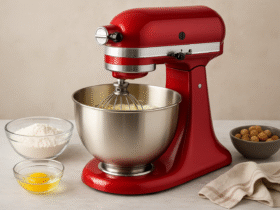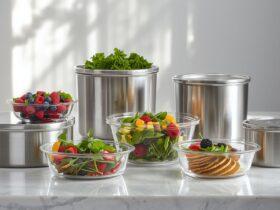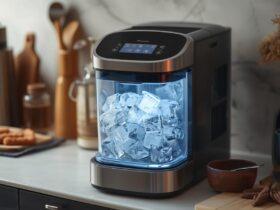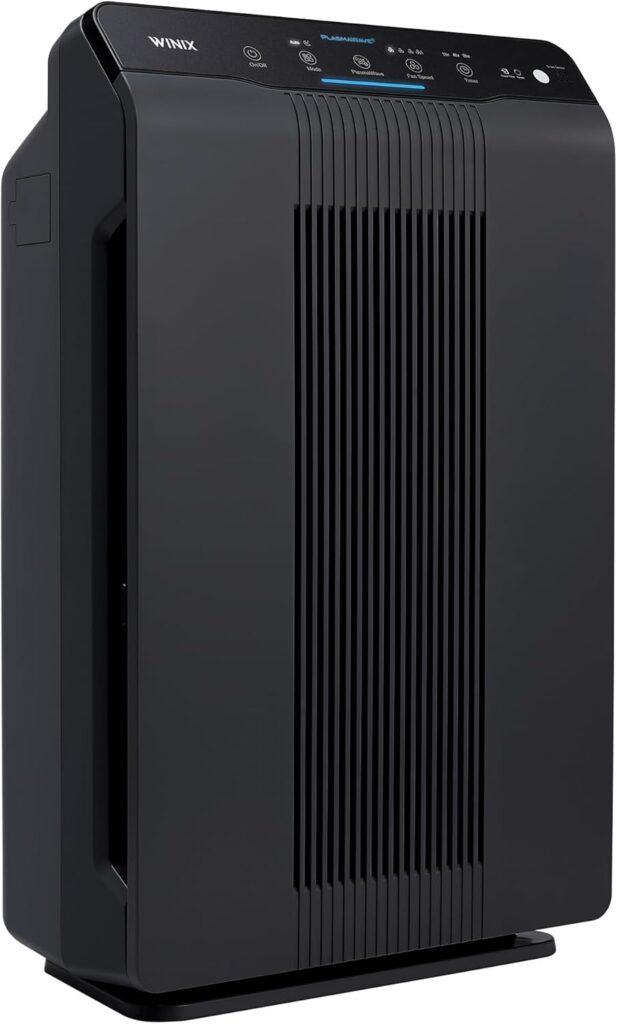Is Your Kitchen Air Safe? A Deep Dive into Kitchen Air Purifiers

Table of Contents
Your kitchen is the heart of your home, but it can also be a hub for various odors, smoke, and pollutants. A good kitchen air purifier is essential to maintain a clean, fresh, and healthy environment.
The World Health Organization tells us that around 2.4 million people worldwide cook in ways that create harmful indoor air pollution. High-temperature cooking releases volatile organic compounds that linger for days and stick to fabrics and surfaces. These compounds do more than create unpleasant smells – they trigger mild headaches and can lead to serious breathing problems.
This piece will guide you through selecting the right kitchen air purifier that matches your needs. You’ll learn about HEPA and carbon filters, proper sizing, and the best placement spots to make your air purifier work effectively.
Why Kitchen Smells Need Special Attention
Those strong cooking smells from fish, curry, and fried foods might seem like a minor annoyance, but research points to something more concerning. Studies show cooking releases large amounts of particulate matter and potentially hazardous chemicals in both particle and gas phases.
Health effects of cooking fumes
Cooking fumes affect health in ways that go well beyond unpleasant smells. People exposed to cooking fumes face higher risks of respiratory diseases, cardiovascular problems, and lung cancer. When cooking temperatures reach 300°C, toxic compounds like aldehydes and alkanoic acids form and irritate the airway mucosa. High-temperature frying also creates aerosols with tiny particles (20-500 nm) that can penetrate deep into the lungs.
Understanding Air Purifier Basics
Kitchen air purifiers use a sophisticated yet straightforward process to remove cooking odors and harmful particles from your kitchen air. You can make better purchase decisions by learning how these devices work and what makes them effective.
How air purifiers work
Your kitchen air purifier draws contaminated air through a fan system and passes it through multiple filtration layers. Clean air then flows back into your kitchen space. Modern air purifiers use both mechanical and chemical filtration processes to combat different types of pollutants.
The high-efficiency air filter acts like a tightly woven net that captures particles as air flows through it. These filters remove at least 99.97% of airborne particles as small as 0.3 microns. They catch everything from visible dust to microscopic cooking particles that could settle in your lungs.
Key parts of an air purifier
A kitchen air purifier combines several vital components that work together:
✨ Fan System: Moves air through the unit and distributes clean air back to your space
✨ Pre-filter: Stops larger particles like dust and food debris
✨ HEPA Filter: Traps 99.97% of particles measuring 0.3 microns
✨ Activated Carbon Filter: Eliminates cooking odors and gaseous pollutants
✨ Control Panel: Adjusts fan speed and monitors air quality
Component effectiveness depends on quality and design. The filtration system works through multiple stages, and each layer targets specific pollutants. The clean air delivery rate (CADR) shows how much filtered air your purifier provides. This rating combines the filter’s surface area and fan strength to determine how well your kitchen air purifier handles cooking fumes and odors.
Essential Features for Kitchen Air Purifiers
Three features make a kitchen air purifier truly effective at handling cooking odors and harmful fumes. Let’s look at what makes these features vital to your kitchen’s air quality.
Carbon filters for odor removal
A high-quality activated carbon filter acts as your first line of defense against kitchen odors. These filters use pellet-based activated carbon that absorbs cooking smells through adsorption. The amount makes a big difference – experts say you need 5-15 pounds to remove odors effectively in kitchen settings.
Kitchen-specific models need substantial carbon filtration, unlike simple air purifiers. Your carbon filter traps gaseous pollutants and volatile organic compounds (VOCs) that HEPA filters can’t catch on their own.
HEPA filtration benefits
True HEPA filters are the foundations of effective air purification in your kitchen. These filters catch at least 99.97% of airborne particles that measure 0.3 microns in diameter. Your kitchen benefits from this level of filtration because it captures:
✨ Smoke particles from cooking
✨ Mold and fungal spores
✨ Dust and allergens
✨ Airborne bacteria and pathogens
Keep in mind that HEPA filters can’t eliminate all kitchen-related pollutants by themselves. The EPA confirms that HEPA filters need carbon-based filtration support to curb odor-causing particles effectively.
Air quality sensors
Modern kitchen air purifiers come with built-in air quality sensors that offer up-to-the-minute monitoring of your kitchen’s air. These smart sensors detect air quality changes and adjust the purifier’s settings automatically.
The best sensors track multiple air quality factors, including:
✅ Particulate matter (PM2.5 and PM10)
✅ Volatile organic compounds (VOCs)
✅ Carbon dioxide levels
✅ Temperature and humidity
Quality sensors show this information through simple color-coded systems – usually green means good air quality and red indicates poor conditions. This automatic monitoring helps busy cooks who can’t manually adjust their air purifier settings while preparing meals.
Advanced models can connect to smart home systems, and your air purifier works with other devices to manage air quality optimally. This smart integration maintains consistent air quality without constant adjustments.
Choosing the Right Size
The best air purifier for kitchen odors depends on accurate measurements and performance ratings. The right size will give your space effective air-cleaning power.
Measuring your kitchen space
A tape measure helps determine your kitchen’s dimensions. You can calculate the square footage by multiplying length by width. A kitchen that measures 15 feet by 20 feet gives you 300 square feet of space. Your ceiling height plays a key role – standard calculations work with 8-foot ceilings. Taller ceilings require an air purifier with more capacity.
These room size categories will help you choose your kitchen air purifier:
✅ Small kitchens (up to 200 square feet): Ideal for compact apartments
✅ Medium kitchens (201-399 square feet): Perfect for open-concept layouts
✅ Large kitchens (400+ square feet): Best for spacious cooking areas

Understanding CADR ratings
The Clean Air Delivery Rate (CADR) shows how well an air purifier works. This rating tells you how quickly a unit cleans the air in a specific room size. Higher CADR numbers mean faster and better air cleaning.
The “two-thirds rule” helps you size your kitchen air purifier – your unit’s CADR should be at least two-thirds of your kitchen’s square footage. A 300-square-foot kitchen needs an air purifier with a minimum CADR of 200.
Ceiling height will affect your choice substantially. CADR ratings work with standard 8-foot ceilings, but many modern homes have 9-foot, 10-foot, or vaulted ceilings. You’ll need an air purifier with a higher CADR rating for tall ceilings.
Kitchen settings need optimal performance, so look at the CFM (cubic feet per minute) rating. A good measure is 100 CFM for every 250 square feet of space. This gives your kitchen air purifier enough power to handle the heavy-duty cleaning needed in cooking areas. Kitchens typically need more air changes per hour than other rooms.
Note that CADR measurements focus on three main pollutants: smoke, dust, and pollen. The smoke CADR rating matters most for kitchen use since it relates directly to cooking-related air quality issues.
Best Places to Put Your Kitchen Air Purifier
Your kitchen’s air purifier can distinguish between clean and stale air. The right spot will give you maximum capture of cooking fumes and the best air circulation in your kitchen space.
Distance from the cooking area
Your kitchen air purifier works best when you place it near the stove or cooking area to capture smoke, grease, and food odors at their source. The ideal location is on the countertop next to the stove or on a nearby shelf. A kitchen island can also serve as an excellent spot for your air purifier.
Kitchens with limited ventilation need an air purifier in the middle of the room, close to where people gather and sit on a counter. This setup helps stop pollutants from building up to dangerous levels. Your air purifier’s height affects its performance – floor placement catches heavier particles like dust, but lifting it slightly often gives better results in capturing airborne cooking pollutants.
Airflow considerations
Good air purification needs proper airflow around your device. Most air purifiers pull in air from the top, so you must keep the intake vents clear. You should follow these clearance requirements to get the best performance:
✅ Maintain at least 6 inches of space in every direction
✅ Keep vents pointed toward the middle of the room
✅ Avoid corners and tight spaces
✅ Position away from walls and furniture
Place the air purifier away from ventilation sources in kitchens with existing ventilation systems. This setup lets the purifier catch particles while the ventilation system handles the rest, creating an effective dual-cleaning system. Areas with less ventilation need air purifiers the most since these spots collect more pollutants.
Room circulation plays a vital role in your kitchen air purifier’s performance. Put the device where fresh air can reach it, but not directly below windows or doors, where cross ventilation might disrupt its operation. This arrangement helps the air purifier pull in and clean the air without fighting other airflow sources.
Note that burning food and overheated oils add substantially to air pollution. Keep your air purifier close to cooking areas, but not so close that heat or excessive grease might damage it. This balance between proximity and protection helps your air purifier work better and last longer.

Types of Kitchen Air Purifiers
Kitchen air purifiers come in different types based on space limits and what you need. You can choose between small countertop units and powerful whole-room solutions. Each type helps tackle cooking odors and smoke in its own way.
Portable units
Portable kitchen air purifiers add flexibility to your cooking space. The AirHood shows what these units can do – it weighs under 6 pounds with a 13-inch footprint. This compact air cleaner works like a mini range hood and removes smoke, steam, and cooking odors wherever you place it. These units work great in:
✅ Small apartments and studio kitchens
✅ RV and boat galleys
✅ Dorm rooms and break rooms
✅ Outdoor cooking areas
Most portable Air Purifier models use dual-filter technology. They combine oil filters to catch grease with activated charcoal filters to absorb toxins. You can adjust their speed settings and run them on AC power or rechargeable batteries. A single charge lasts up to eight hours.
Large Air Purifier-capacity models
Large-capacity kitchen air purifiers work best in cooking areas over 500 square feet. These units pack impressive power – some models cut smoke levels by more than 99.9% at full power. Smart features let you control them through mobile apps or voice assistants. These powerful units use cylindrical filters with large surface areas to clean more air quickly. Manufacturers focus on energy savings, too.
Under-cabinet options
Under-cabinet kitchen air purifiers give you a permanent solution without using counter space. They mount under your kitchen cabinets and filter air while keeping a clean look. Small kitchens benefit from their space-saving design, but their strong motors work well in bigger spaces, too.
You can install and use most under-cabinet models in different ways. New units come with adjustable speeds and advanced filters that remove both particles and glass. You’ll find these purifiers in various finishes, from stainless steel to matte black, so they match any kitchen style.
Your specific needs will help you pick the right type. Portable units give you flexibility, large-capacity models suit open spaces, and under-cabinet options save space while working permanently. Each type has its strengths in keeping your kitchen air clean.
Maintenance and Filter Changes
Regular maintenance will keep your kitchen air purifier running at peak performance. A well-maintained unit removes cooking odors more effectively, lasts longer, and uses less energy.
Cleaning schedule
Your kitchen air purifier needs consistent attention to work well. We focused on the pre-filter that needs cleaning every 2-4 weeks. This first line of defense catches larger particles and stops the main filters from getting clogged too quickly.
Pre-filter maintenance steps:
1. Vacuum with a brush attachment
2. Rinse with warm water when needed
3. Let it dry completely before reinstalling
Your purifier’s exterior needs attention, too. Keeping the surface clean stops dust from recirculating into your kitchen air. A monthly wipe-down with a damp cloth helps maintain proper airflow through the unit.
When to replace filters
Each component of your air purifier for kitchen odors has its own lifespan. The main HEPA filter typically lasts 8,760 hours or about 12 months. The activated carbon filters that tackle kitchen odors need replacement every 3-6 months.
You’ll know it’s time for a filter change when you notice:
1. Weak airflow from the unit
2. Unpleasant, musty odors
3. Visible dirt on the filter
4. Higher electricity bills
Yes, many modern kitchen air purifiers indeed come with built-in filter change indicators. These smart sensors track filter life and alert you when replacement is needed. Note that these indicators work based on average use – heavy cooking might need more frequent changes.
Environmental factors affect filter life beyond regular schedules. Homes with frequent cooking, pets, or high outdoor pollution levels need more frequent filter changes. Some households might need to replace filters every 6 months instead of annually.
Maintenance costs vary based on usage patterns and filter types. Energy-efficient models typically cost under $35 annually to operate. Your unit’s specifications and cooking frequency determine filter replacement expenses. Having spare filters on hand will give a quick replacement option when needed.
Choosing the Right Air Purifier for Your Kitchen Needs
With so many options available, selecting the right air purifier for the kitchen can feel overwhelming. Here’s a step-by-step guide to help you narrow down your choices:
Assess Your Kitchen Size: Measure your kitchen’s square footage to determine the appropriate coverage area for the air purifier.
Identify Your Primary Concerns: Are you primarily concerned about cooking odors, smoke, or allergens? Choose an air purifier with the appropriate filters to address your specific needs.
Consider Your Budget: Air purifiers range in price from under $100 to over $500. Set a budget before you start shopping to avoid overspending.
Read Reviews: See what other customers have to say about the air purifiers you’re considering. Look for reviews that mention performance, noise level, and filter replacement costs.
Conclusion
An air purifier for kitchen smells is essential to keeping indoor air healthy. Our complete research shows that picking the right air purifier for kitchen odors depends on several key factors.
Your kitchen’s size must match a properly rated unit that has both HEPA and substantial carbon filtration. These components work together and tackle both particles and lingering cooking smells. Placing the unit near your cooking area and maintaining it properly helps your air purifier work best against kitchen smoke and odors.
The original price might seem steep, but the health benefits are worth much more than the cost. You can manage long-term expenses by changing filters regularly and running the unit efficiently while keeping your kitchen air clean.
You have options to pick from – a portable unit offers flexibility, a large-capacity model suits open layouts, and an under-cabinet option saves space. Your kitchen air purifier creates a fresher, healthier cooking environment. Note that clean air makes cooking more enjoyable and protects your family’s health.
FAQ
Q1. Are kitchen air purifiers noisy?
A1. Most modern air purifiers are designed to operate quietly. Look for models with noise ratings if you prefer a quieter appliance while cooking.
Q2. Where to put an air purifier in the kitchen?
A2. Place it near cooking areas but away from direct heat, steam, and water. Keep it in an open space for better airflow and efficiency.
Q3. Do air purifiers remove dust?
A3. Yes! HEPA filters trap dust particles, reducing buildup on surfaces and improving indoor air quality. Regular filter changes keep it effective.
Q4. Do air purifiers use a lot of electricity?
A4. No, most are energy-efficient. A typical unit uses 30-100 watts, similar to a light bulb. Look for Energy Star-certified models to save power.
Q5. Do air purifiers work with windows open?
A5. They still work, but efficiency drops as outdoor air brings in new pollutants. For best results, keep windows closed while using it.









Leave a Reply